 |
 |
 |
HOME > FOCUS > Kamisaka Sekka: Looking Forward, with an Eye on Tradition |
 |
 |
Focus features two in-depth reviews each month of fine art, architecture, and design exhibitions at art museums, galleries, and alternative spaces around Japan. |
|
|
 |
 |
 |
Kamisaka Sekka: Looking Forward, with an Eye on Tradition
J.M. Hammond |
 |
Kamisaka Sekka, Flowers and Grasses of the Twelve Months, April (left) and December (right), 20th century, Hosomi Museum |
The late Meiji era (1868-1912) was a time of rapid change and upheaval, a turning point when Japanese artists had to decide for themselves the path they would take. For the artist and designer Kamisaka Sekka, this choice involved taking a few steps back in time to enable him to make a leap forward.
A new exhibition at the Panasonic Shiodome Museum of Art in Tokyo puts the spotlight on Kamisaka and the style of art he is most associated with, Rinpa (also spelled Rimpa). Kamisaka Sekka: Inheriting the Timeless Rimpa Spirit has on display over 60 of the artist's works, in various media, supported by a further 20 or so items by his predecessors that provide background to his career. Many of the exhibits are on loan from the Hosomi Museum in Kyoto, which has one of the most thorough collections of Kamisaka's works and is one of the three museums at which this show was held over the course of more than a year before ending its run now in Tokyo.
|
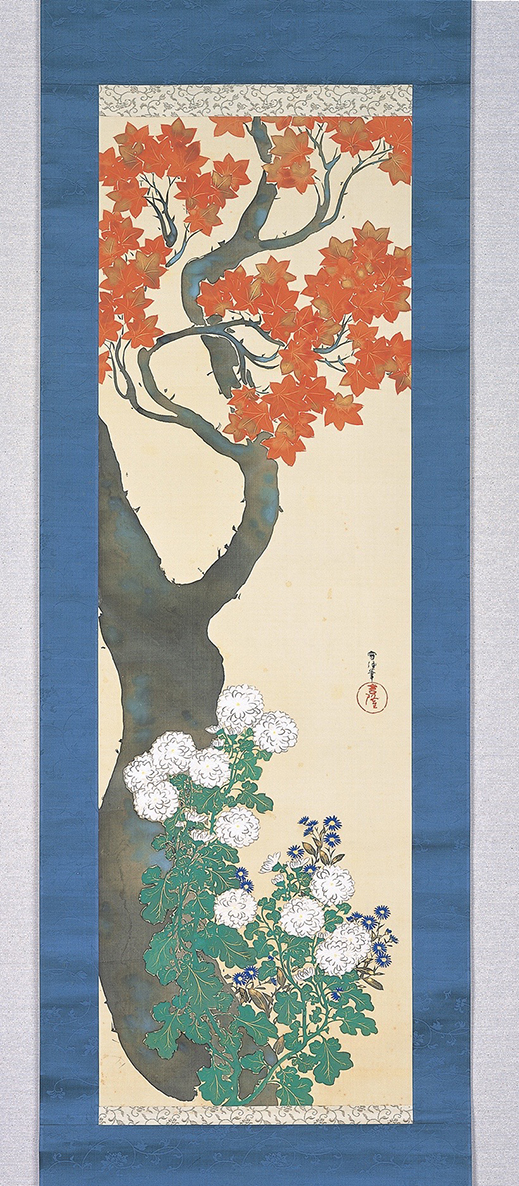 |
|
|
|
Kamisaka Sekka, Autumn Maple and White Chrysanthemums, 20th century, Hosomi Museum
|
Kamisaka (1866-1942) was born to a samurai family in Kyoto. After studying Japanese art in his twenties, he shifted his focus to design, although he did not give up on fine art entirely. The Japanese government sent Kamisaka to the World Expo in Glasgow in 1901, at a time when the influence of Japanese aesthetics was visible in the burgeoning Art Nouveau movement in Europe, following the explosion of Japonism in previous decades. Kamisaka was interested in finding out exactly what it was about Japanese art that had captured the imagination of Europeans. He himself came under the influence of Art Nouveau to an extent, but rather than spur him to follow the trends current in the West, his direct contact with Europe actually reinforced his identification with the artistic legacy of his own country.
In particular, he consciously picked up the trail of the 300-year-long Rinpa tradition, a trail that had largely gone cold even before his day as new styles emerged and made Rinpa appear obsolete. The tradition emerged in Kamisaka's hometown of Kyoto in the works of Tawaraya Sotatsu (c. 1570-1640) and Hon'ami Koetsu (1558-1637), then was consolidated as a style by Ogata Korin (1658-1716) and others. It can be characterized by its decorative flair, attention to detail, and, often, its lavish use of silver and gold leaf. Some representative examples of Rinpa works open the exhibition to provide an introduction to Kamisaka's artistic roots; these include some designs on fans, and half a dozen scrolls.
One of these scrolls is Tawaraya Sotatsu's Two Puppies, a lively expression of soft fur and the charming gestures of animals at play.
Animals, especially birds, along with flowers, were particularly common motifs in Rinpa works, as they had long been in Japanese art in general. Also included here is Hollyhocks by Fukae Rotsu, an 18th-century Rinpa artist, in which the summer flower is depicted in gentle pinks, whites, and ink wash. This delicate Rinpa work is one of a number in the early part of the exhibition that was in Kamisaka's personal possession -- a fact that attests to his enthusiasm for the style.
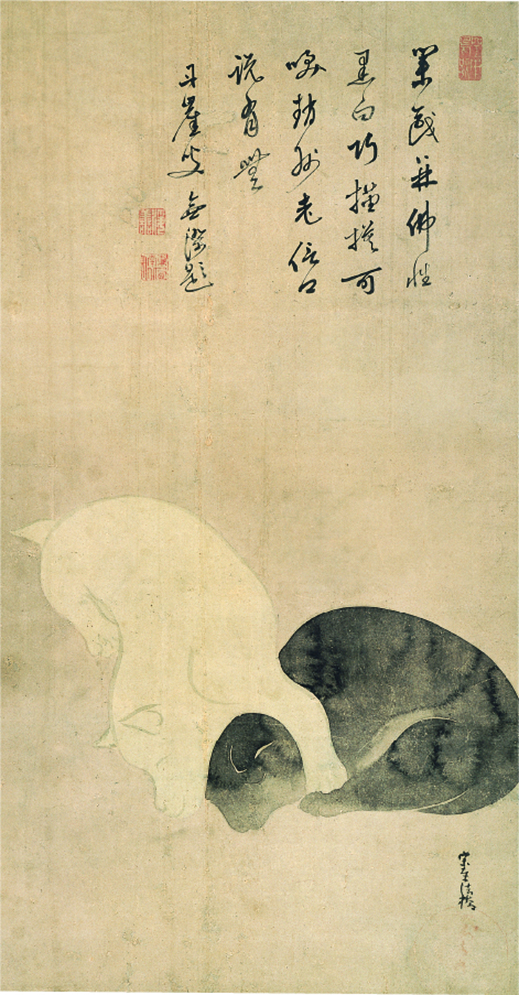 |
|
 |
|
|
|
|
Tawaraya Sotatsu, Two Puppies, 17th century, Hosomi Museum
|
|
Fukae Rotsu, Hollyhocks, 18th century, Hosomi Museum |
|
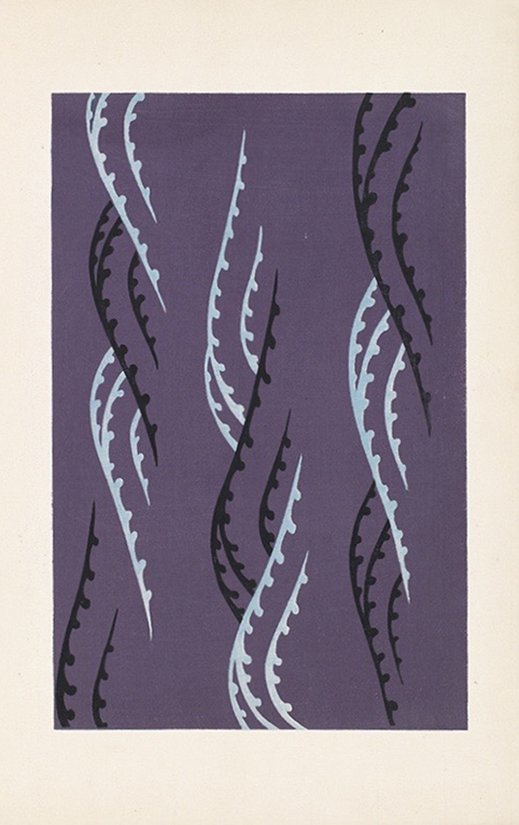 |
|
|
|
From Kamisaka Sekka, Senshoku zuan kairo (One Hundred Patterns of Waves), published in 1902, Hosomi Museum
|
The exhibition then moves on to examine various aspects of the career of Kamisaka himself. One section concentrates on his graphic work, including his designs of flower, butterfly and other motifs from nature. The Meiji era saw a surge in demand for pattern designs for use in everything from kimono fabric to book covers, and these were often collected in design books called zuan. The show highlights some of the design books that helped make Kamisaka's name, including pages from his Senshoku zuan kairo, a collection of 100 wave patterns.
Widely considered Kamisaka's zuan masterpiece is Momoyogusa, or "Flowers of a Hundred Worlds," from 1909, and one wall of the exhibition features several individual prints from this publication. One of the most striking images from this collection is his depiction of ivy leaves that have turned red, probably when the temperature has dropped. While some traditional Japanese art can have a calm, even static feel, this image exudes a certain dynamism, perhaps influenced by Rinpa. The contrasting diagonal lines of the ivy stalks are depicted with energetic strokes, which in turn interplay with the negative space on the right of the composition.
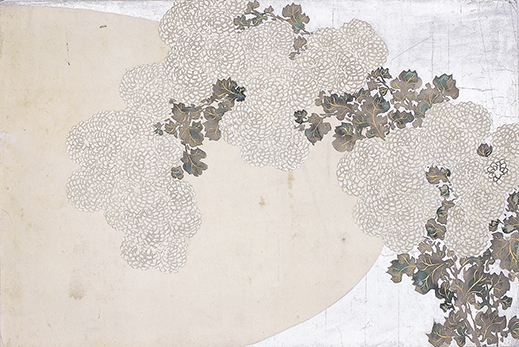 |
|
From Kamisaka Sekka, Momoyogusa (Flowers of a Hundred Worlds), original drawings, c. 1909, Unsodo |
The next section of the show looks at items such as lunch boxes, trays, and tea bowls -- what in today's parlance might be termed "product design." But this was not a modern trait in Kamisaka's time; the production of beautiful objects for everyday use was a core part of the democratizing thrust of Rinpa. The tradition was the first in Japan that took the world of artistic objects beyond the confines of the temples and the aristocracy and into the hands of citizens (albeit merchants and others with sufficient financial resources).
A key aspect of this type of production saw Rinpa artists collaborating with artisans specializing in lacquerware, ceramics, or other media, and Kamisaka continued with this approach, his contribution being the decoration of the completed objects. He often worked with his younger brother, the lacquer artist Kamisaka Yukichi. One example here is a food box in deep black decorated with a cherry-blossom design and also featuring the classic Rinpa motif of a flowing river. There are numerous examples here of designs Kamisaka painted on ceramic dishes, trays and tea bowls.
 |
|
Design by Kamisaka Sekka, lacquer by Kamisaka Yukichi, Half-moon Shaped Covered Food Box with Design of Cherry Blossoms, 20th century, private collection |
The exhibition comes to a climax in the last room, where two sets of large folding screens take up an entire wall each, accompanied by half a dozen colorful hanging scrolls. The first of the screens is based on a Rinpa masterpiece, Ogata Korin's famous Irises. As both works make liberal use of gold leaf, at first glance Kamisaka's interpretation may not seem so radically different from Korin's original, but he does make some substantial changes. Kamisaka's two screens, while smaller, are also closer to square in their dimensions, rather than the usual rectangular shape. This not only allows for more negative space above and below the irises, but also enables him to exaggerate the original zigzag arrangement of the flowers. In addition, where Korin's irises were uniformly deep blue, Kamisaka introduces some splashes of white. Kamisaka thus pays due respect to his artistic forerunners, but also shows he is not bound by convention. In that respect his Irises is a fitting way to bring Kamisaka Sekka: Inheriting the Timeless Rimpa Spirit to a close.
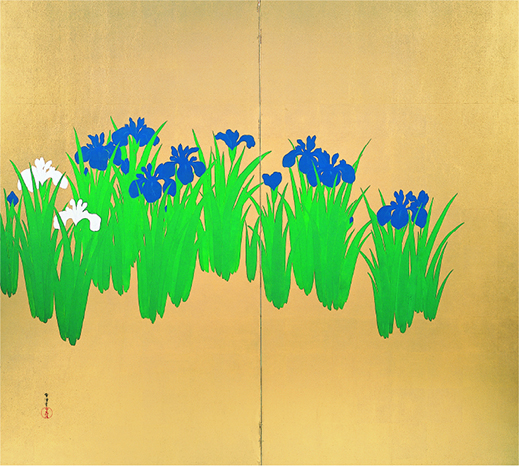 |
|
Kamisaka Sekka, Irises, 20th century, private collection |
All images courtesy of Panasonic Shiodome Museum of Art. |
 |
 |
J.M. Hammond
J.M. Hammond has been researching and writing about Japanese art, traditional and modern, in various media for close to two decades. He has had essays on art and cinema printed in various book projects. These include "A Sensitivity to Things: Mono No Aware in Late Spring and Equinox Flower" in Ozu International: Essays on the Global Influences of a Japanese Auteur (Bloomsbury, 2015) and "The Collapse of Memory: Tracing Reflexivity in the Work of Daido Moriyama" for The Reflexive Photographer (Museums Etc, 2013) [reprinted in the same publisher's 10 Must Reads: Contemporary Photography (2016)]. He has given various conference papers, including at the University of Hong Kong and the University of Oxford.
|
|
 |
|
|
 |
|
 |
|